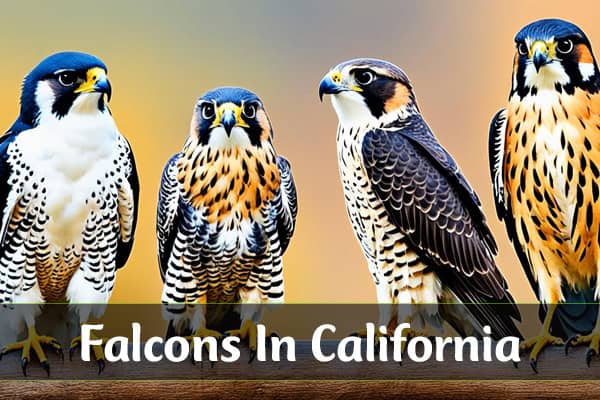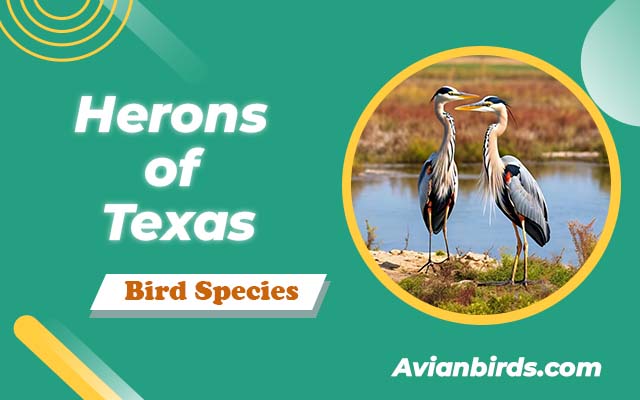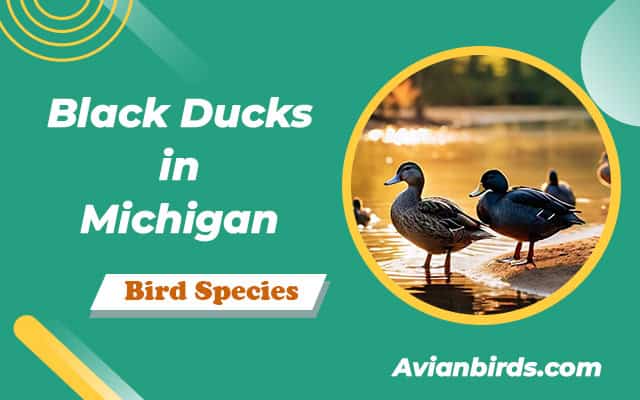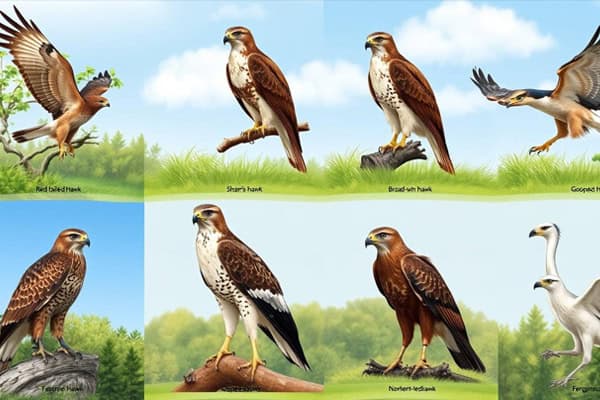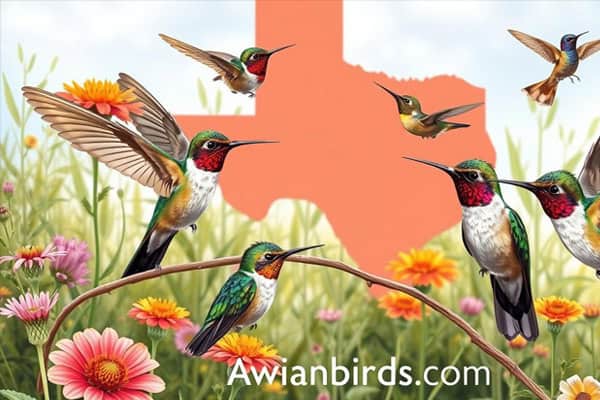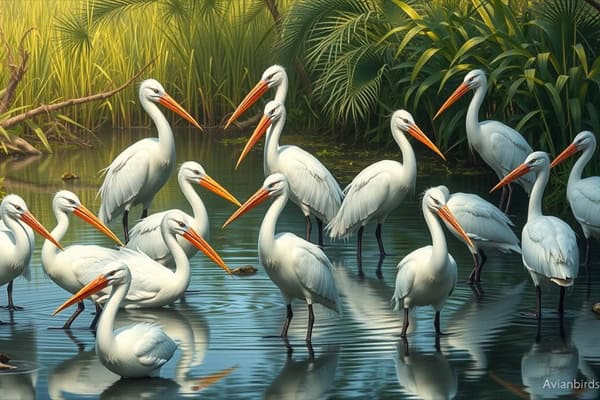4 Types Of Falcons In California (ID Guide With Pictures)
Here we’ll discuss the amazing world of falcons in California. This state is a hotspot for bird lovers, with a wide variety of these fascinating birds of prey. You’ll meet the speedy Peregrine Falcon and the tiny American Kestrel, among others. Each one is crucial to California’s diverse ecosystems.
In this guide, we’ll discuss the unique traits, habits, and conservation status of California’s 4 main falcon species. Join us as we discover the secrets of these incredible birds!
Falcons In California
California is known for its wide range of birds, with over 700 species. This makes it the state with the most bird species in the US. The state’s varied landscapes, from deserts to mountains, support this rich bird life. Among these, falcons are fascinating birds of prey.
California is home to seven falcon species, with four being quite common: the Peregrine Falcon, American Kestrel, Prairie Falcon, and Merlin. These birds are fast and skilled hunters. They play a key role in keeping the ecosystem balanced by controlling animal populations.
- Peregrine Falcon
- American Kestrel
- Prairie Falcon
- Merlin
Learning about the habitats and behaviors of these falcons can deepen our appreciation for California’s nature. Whether you love birdwatching or just enjoy the outdoors, discovering California’s falcons can make your connection to nature stronger.
| California Falcon Species | Key Characteristics |
|---|---|
| Peregrine Falcon | Fastest bird in level flight, capable of diving at over 200 mph |
| American Kestrel | Smallest falcon in North America, known for its distinctive hovering behavior |
| Prairie Falcon | Powerful falcon adapted to the open landscapes of the western United States |
| Merlin | Compact and agile falcon, often seen hunting songbirds in urban areas |
This guide focuses on four falcon species found in California. It provides insights into their identification, behavior, and conservation status.
1. Peregrine Falcon
- Scientific name – Falco peregrinus
- Lifespan – 13 years (average)
- Size – (36 to 49 cm)
- Weight – (530 to 1600 g)
- Wingspan – (100 to 110 cm)
The peregrine falcon is a standout among California’s falcons. It’s known for its unique looks and exciting behavior. These birds have caught the eye of many nature lovers and birdwatchers.
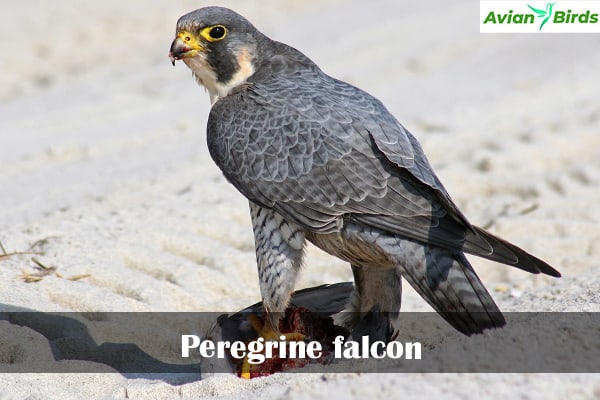
Identification and Appearance
The peregrine falcon is a medium-sized bird of prey. It has long, pointed wings and a sleek body. Adults have a blue-grey back, a dark head, and a thick “mustache” near their beak. Their belly is whitish with horizontal bars on the chest.
Juveniles look different with a brownish back and a less clear facial pattern.
Nesting and Breeding
Peregrine falcons like to nest in open spots with tall structures. They use cliffs or tall buildings to hunt from. They often take over old nests, adding sticks to make their home.
Diet and Hunting
Peregrine falcons are top hunters. They eat many bird species, like doves, pigeons, and waterfowl. They dive at their prey at speeds over 200 miles per hour.
Conservation Status
Thanks to conservation, the peregrine falcon has bounced back from the 1960s. DDT had threatened them, but now they’re thriving. Their numbers are growing in California and North America.
Where to Find Peregrine Falcons in California
You can find peregrine falcons all over California. They’re most common near the coast, big waters, and mountains. Places like Morro Bay, Yosemite National Park, and the Santa Cruz Mountains are great spots to see them.
2. American Kestrel
- Scientific name – Falco sparverius
- Lifespan – 5 years (average)
- Size – (22 to 31 cm)
- Weight – (80 to 165 g)
- Wingspan – (51 to 61 cm)
The American kestrel California is a small but powerful falcon found in California. They stand out with their rusty backs, blue wings, and boldface markings. Let’s explore the world of the American kestrel, including how to identify them, where they live, what they eat, and how we can help them.
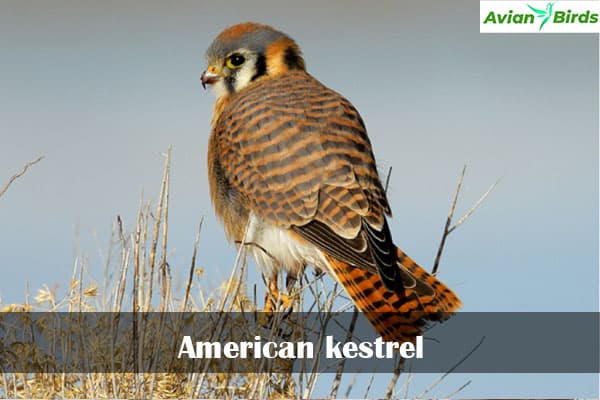
Identification and Appearance
The American kestrel is the smallest falcon in North America. Males have a rusty back with black bars and blue wings. They also have a whitish to rusty underside. Females are rusty all over, with black bars on their back and wings.
Nesting and Breeding Habits
American kestrels nest in cavities, like old woodpecker holes or nest boxes. They lay 3-7 eggs and take turns incubating them for a month. After that, the chicks hatch.
Diet and Hunting Strategies
The American kestrel diet includes small insects, spiders, small mammals, and birds. They hover in the air to scan the ground for food. This hunting method helps them catch their prey.
Conservation Concerns
American kestrel conservation is now more important than ever. Their numbers have dropped by 53% in the U.S. over 50 years. This is mainly due to habitat loss, lack of nesting sites, and pesticides.
Understanding the American kestrel’s habitat and their behavior helps us protect these birds. We can all help ensure their future in California’s diverse landscapes.
3. Prairie Falcon
- Scientific name – Falco mexicanus
- Lifespan – 3 years (average)
- Size – (37 to 47 cm)
- Weight – (420 to 1100 g)
- Wingspan – (90 to 113 cm)
The prairie falcon is a bird of prey that lives in California. It has brown upperparts and a pale, whitish underside. Let’s learn about its identification, nesting, diet, and conservation.
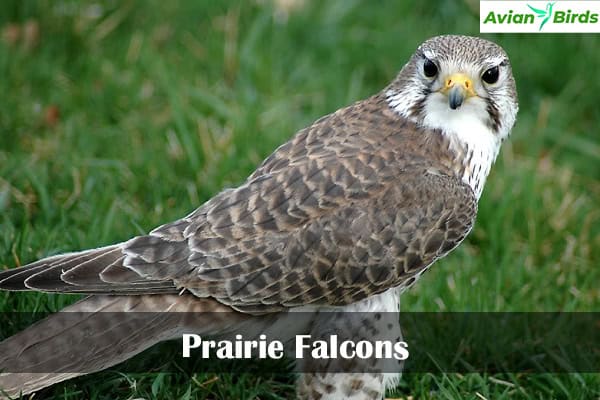
Identification and Appearance
The prairie falcon stands out with its dark underwing linings. Its long, pointed wings and tail make it look sleek. You can also see brown marks on its belly and breast.
Nesting and Breeding Behavior
These falcons live in open areas, nesting on cliffs and bluffs. They use a nest made of loose debris. In the breeding season, they show off their aerial displays and care for their young.
Diet and Hunting Techniques
Their diet includes small mammals like ground squirrels and pikas. They also eat birds and insects. With their strong talons and agile flying, they hunt using different techniques.
Conservation Status and Threats
There are about 80,000 prairie falcons worldwide, so they’re not endangered. But, they face threats from pesticides and hunting. Conservation efforts help protect their habitat and ensure their survival in California and other places.
4. Merlin
- Scientific name – Falco columbarius
- Lifespan – 3 years (average)
- Size – (24 to 30 cm)
- Weight – (160 to 240 g)
- Wingspan –(53 to 68 cm)
The Merlin, also known as Falco columbarius, is a small but powerful falcon found in California. It has caught the eye of birdwatchers and nature lovers with its unique look and interesting ways. This bird is a must-see for those who love the outdoors.

Identification and Appearance
Merlins are a bit bigger than the American Kestrel and have a special wing shape. Males are dark on top with a light, orange chest. Females are lighter with white undersides. They have sharp talons and a hooked beak, perfect for hunting.
Habitat and Range
In California, merlin falcons live in many places, from shrublands and coasts to cities. They can be found in different ecosystems, making them easy to spot for birdwatchers.
Behavior and Diet
Merlin falcons are bold and defend their territory fiercely, sometimes attacking cars that get too close. They are quick and catch birds, insects, and small mammals with ease.
The Merlin Falcon is a fascinating bird that enriches California’s bird life. Learning about its look, where it lives, and how it acts helps us value and protect this amazing bird.
Top Birding Destinations for Falcons in California
California is a paradise for bird lovers, especially those who want to see falcons. You can find many great places to watch these amazing birds. Some top spots include:
- Point Reyes National Seashore
- Klamath Basin National Wildlife Refuges Complex
- Arcata Marsh and Wildlife Sanctuary
- Elkhorn Slough National Estuarine Research Reserve
- Golden Gate National Recreation Area
- Yosemite National Park
- San Gabriel Mountains
- Bolsa Chica Ecological Reserve
- Cabrillo National Monument
- Andrew Molera State Park
- Morro Bay
These places are great for seeing four types of falcons: Peregrine Falcon, American Kestrel, Prairie Falcon, and Merlin. Each type has its special traits and ways of behaving. Birdwatchers love to see and learn about these birds.
| Destination | Notable Falcon Species | Best Time to Visit |
|---|---|---|
| Point Reyes National Seashore | Peregrine Falcon, American Kestrel | Year-round, with peak migration in spring and fall |
| Klamath Basin National Wildlife Refuges Complex | Peregrine Falcon, Prairie Falcon | Winter months |
| Arcata Marsh and Wildlife Sanctuary | Peregrine Falcon, American Kestrel | Year-round |
| Bolsa Chica Ecological Reserve | Peregrine Falcon, American Kestrel | Year-round, with peak migration in spring and fall |
If you love birds or are new to falcons, California has amazing places to see them. These spots let you see the power, beauty, and grace of these raptors in nature.
Tips for Identifying and Observing Falcons
Watching and identifying falcons in California is thrilling for bird lovers. There are many guides and resources to help you. They teach you how to spot falcons and improve your birdwatching skills.
Field Guides and Resources
Great field guides for California falcons include the National Geographic Guide to the Birds of North America. Also, check out Birds of Prey of the East and Birds of Prey of the West. These guides offer detailed info on falcon looks, behaviors, and where they live. This helps with accurate identification.
Check Our Previous Articles:
There are more resources for falcon-watching tips and techniques. Websites and blogs have articles on identifying California falcons and where to find them. Local birding groups or nature centers might offer workshops or tours on falcon watching.
To see falcons, be patient and use binoculars or a spotting scope. Learn the unique signs and flight patterns of each falcon type. Knowing these features helps you spot and identify falcons in California’s varied habitats.
| Field Guide | Falcon Identification Features | Availability |
|---|---|---|
| National Geographic Guide to the Birds of North America | Detailed descriptions of physical characteristics, behaviors, and habitats of falcon species | Widely available in bookstores and online retailers |
| Birds of Prey of the East | Specialized guide focusing on falcon and other raptor species found in the eastern United States | Available through online and specialty booksellers |
| Birds of Prey of the West | Specialized guide focusing on falcon and other raptor species found in the western United States | Available through online and specialty booksellers |
The Importance of Falcon Conservation
Falcons are key to California’s ecological balance. Their numbers have dropped due to habitat loss, pesticides, and illegal hunting. Saving these birds is vital for the state’s bird life and ecosystem health.
Understanding California’s falcons helps us protect them. By knowing their needs, we can help their populations grow. This keeps these amazing birds around and supports the state’s natural balance.
California’s falcon conservation includes several strategies:
- Habitat restoration and protection for falcons
- Stopping illegal hunting and trade
- Reducing harmful pesticides
- Public education for Falcon support
Together, we can keep Falcon Conservation California a top priority. Recognizing the importance of falcon protection helps us protect these predators. This way, we keep California’s nature and biodiversity safe.
| Falcon Species | Conservation Status | Threats | Conservation Efforts |
|---|---|---|---|
| Peregrine Falcon | Least Concern | Habitat loss, pesticide use | Habitat restoration, monitoring, public education |
| American Kestrel | Least Concern | Habitat fragmentation, competition with non-native species | Nest box programs, habitat management, public awareness |
| Prairie Falcon | Least Concern | Habitat loss, human disturbance, illegal hunting | Habitat protection, monitoring, law enforcement, public outreach |
| Merlin | Least Concern | Habitat loss, urbanization, climate change | Habitat conservation, monitoring, public education |
Final Thoughts
California is a great place for those who love falcons. It’s home to many different kinds of these amazing birds. From the fast Peregrine Falcon to the small American Kestrel, they all play a key role in the state’s ecosystems.
These four falcons – the Peregrine Falcon, American Kestrel, Prairie Falcon, and Merlin – each have their own stories. We can learn about their flying skills, hunting ways, and how we can help protect them. This helps us feel closer to nature.
We need to make sure these California falcons and all falcon species in California keep living. We can do this by supporting conservation, respecting their homes, and teaching others about them. Let’s all work together to keep these amazing birds safe for the future in California.

